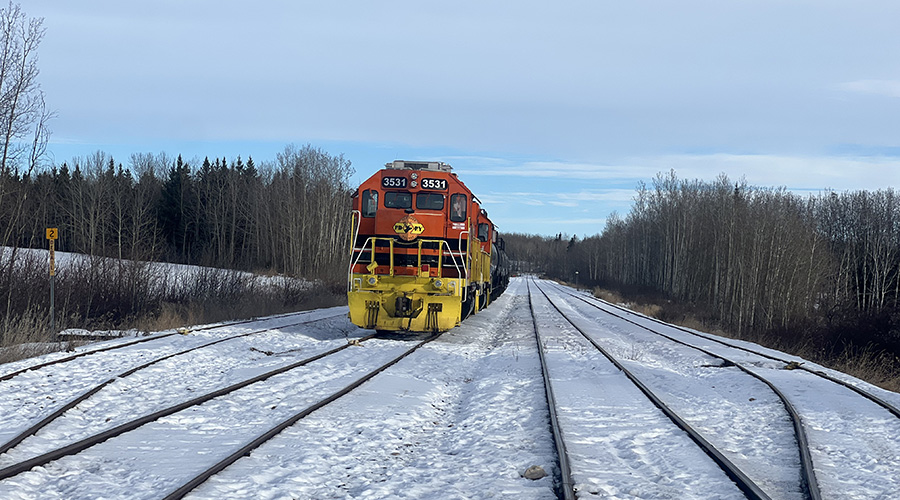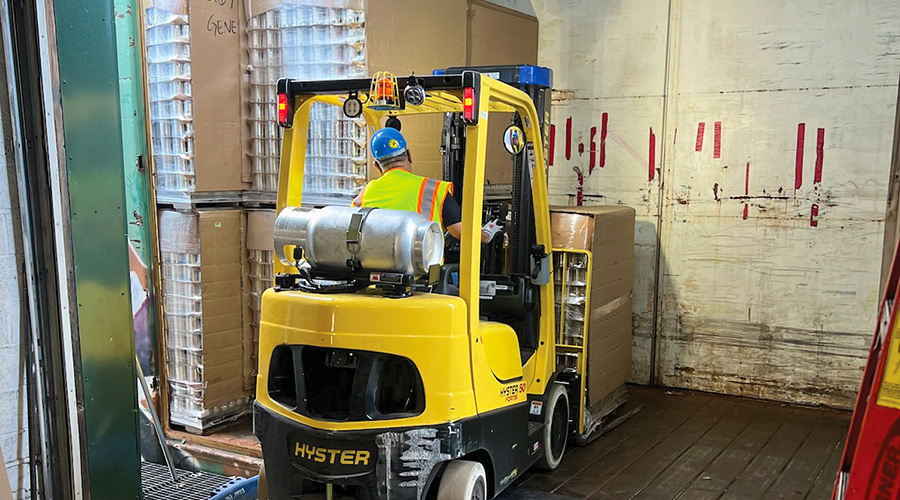To short lines, the 'big haul' of CRISI funding represents a lifeline
11/12/2024
By Julie Sneider, Senior Editor
Last month, the Federal Railroad Administration announced $2.4 billion in Consolidated Rail Infrastructure and Safety Improvement (CRISI) grant awards for fiscal years 2023 and 2024. The funding went to a record 122 rail projects in 41 states designed to improve safety, beef up supply chains and expand freight and passenger rail.
This year, the FRA approved a record $1.29 billion in CRISI grants that were awarded to short line and regional projects across 36 states, according to the American Short Line and Regional Railroad Association (ASLRRA). That amount represents 52% of the CRISI dollars awarded in this round.
The short lines’ share of the funding is important to the nation’s rail system because those smaller railroads are the first- and last-mile service connections for thousands of industrial, manufacturing, energy and agricultural shippers, particularly in small and rural towns, according to ASLRRA. Without those railroads, shippers in those areas would be cut off from the national freight network and global economy, and likely would have to depend on less environmentally friendly and more transportation (trucks) to get their products to market.
That the FRA recognizes short lines are a significant cog in the supply-chain-wheel is a big deal.
As for the short lines themselves, winning a CRISI grant is a big deal.
“For some short lines these awards are utterly transformational, while for others the awards allow them to continue a long journey toward rehabilitating their infrastructure, but for each of them this is a key chapter in their story,” said ASLRRA President Chuck Baker in a press release issued after the grants were announced.
 Manning Grain Co. was founded in 1924 by owner Kent Manning’s grandfather, Earl. Manning Grain Co.
Manning Grain Co. was founded in 1924 by owner Kent Manning’s grandfather, Earl. Manning Grain Co.According to the ASLRRA: 17 projects receiving grants included grade crossing and trespassing safety components; 15 projects call for replacing or upgrading bridges; and10 projects will upgrade or purchase 59 locomotives that are at the Tier 3, Tier 4 or zero-emission levels.
Celebrating a first-time CRISI win
Some short lines were first-time CRISI grant award winners. Among them is Manning Grain Co. and its affiliated Manning Rail Inc., which operates 7 miles of track between Fairmont and Burress in Fillmore County, Nebraska, that ties into BNSF Railway Co.’s mainline.
Manning Grain and Rail’s $5.3 million CRISI grant will go toward a $7.3 million project to rehabilitate the rail line and restore freight-rail transload services to the company’s grain elevator facility. When completed, the project will result in a modal shift for exporting grain and streamlining the supply chain, according to the FRA’s project description.
The ultimate goal? To increase over 100 local grain farm producers’ competitiveness and market reach, according to Kent Manning, president of Manning Grain and Manning Rail. The company and Fillmore County will contribute the 25% nonfederal match required under the CRISI grant program.
“I can hardly emphasize how huge an impact I think this grant [and project] will have for a very large area,” says Manning. “We’ve talked about our local farmers, but you know our outreach now will get grain from 50 miles away from here. And I think that circle could probably get a lot bigger."
Manning Grain was founded in 1924 by Kent’s grandfather, Earl. Over the decades, the facility expanded: Flat storage buildings were added in the 1950s, a wood elevator was constructed (and still stands) in the late 1960s, and several bins and accompanying dump pits with grain legs were built in the 1980s and 1990s.
 “We’re definitely glad that we’re part of the pretty big haul that short lines received as a whole — over $1.2 billion in CRISI grants.” — Fred Oelsner, American Short Line and Regional Railroad Association ASLRRA
“We’re definitely glad that we’re part of the pretty big haul that short lines received as a whole — over $1.2 billion in CRISI grants.” — Fred Oelsner, American Short Line and Regional Railroad Association ASLRRAKent and his family now own the grain company, which he bought from his dad. In 2005, Kent and his wife Cindy bought the rail line so that it could connect to the BNSF mainline. Had they not bought it, the rail line would have been abandoned and torn up, Kent Manning says.
The Mannings then spent the next several years clearing brush and trees off the line and replacing broken ties — initially by hand using a pick and a sledgehammer. At first, Manning Rail offered rail-car storage, but the Mannings’ ultimate objective was to create a short line that could move grain carloads to the BNSF line and then on to a wider market.
“That has been our main goal the whole time — along with the revenue car storage,” says Manning.
By 2012, Manning Rail became an official short line after meeting FRA requirements.
Today, the short line owns three locomotives and employs four people part time, including Kent. The grain company offers over 7 million bushels of grain storage, as well as anhydrous ammonia and liquid fertilizer. Extensive repairs have been done to the line, including the replacement of over 15,000 ties to date.
But the $7.3 million project to rehab the short line on a grander scale is necessary to keep up with the competition to move more grain to the market faster. As a result, the CRISI grant was a “huge deal” to complete that project, Manning says.
“We would have had to try to do this project in steps because we could never have done all the work at once. It would have taken years and years and years down the road to complete the whole thing. And so, doing this project all at once is going to help not only us, but hundreds of farmers.”
Manning isn’t sure when exactly the construction work will get underway.
“We've got a lot of the engineering work already done,” he says. “We have a 90% design with the BNSF railroad already completed, and we have started on our NEPA [National Environmental Protect Act] process.”
Still, Manning knows the project will be completed sooner than later thanks to the funding boost. And he’s excited for what Manning Rail’s restored short line could do to help attract additional businesses in need of rail service.
“This project is going to preserve this infrastructure for generations to come,” he says.
Helping short lines meet regs, cut emissions
Meanwhile, the ASLRRA itself received a $20 million CRISI grant award for a project to advance data collection and analysis that association officials believe will benefit the entire short-line industry.
Specifically, about $19 million of the grant dollars will go toward installation of advanced digital onboard locomotive systems to help collect and analyze data on energy usage, idling and emissions. ASLRRA is partnering with Wi-Tronix to install its Violet® onboard data recording system on 600 locomotives across the country; the recording system will enable short lines to monitor and use their locomotive assets more efficiently, says Fred Oelsner, ASLRRA’s vice president of data technology and security.
The impetus behind the project and grant application was California short lines facing a deadline under the California Air Resources Board’s (CARB) in-use locomotive regulation, which in part will require railroads in the state to start annually collecting and reporting locomotive activity, emission levels and idling data starting in 2025. Eventually, the regulation will also require railroads to upgrade their locomotive fleets to zero-emissions vehicles.
Both the ASLRRA and Association of American Railroads are fighting the regulation in court and have asked the U.S. Environmental Protection Agency to reject CARB’s request for a waiver from federal clean-air laws. From the ASLRRA’s point of view, the regulation is too costly and may put some small railroads out of business.
CRISI helps a California short line facing new regs
The CARB regulation also prompted Trona Railway Co. to apply for a CRISI grant. Last month, the short line learned it will receive a $13 million CRISI grant for the acquisition of three Tier 4 locomotives to replace six, decades-old SD-40 locomotives for line-haul freight service it uses to serve its main customer, Searles Valley Minerals in northern San Bernardino County, California. The short line operates 30.6 miles of mainline where it interchanges with Union Pacific Railroad.
If Trona can get 50% of its fleet to Tier-4 status by 2030, it can avoid penalties under the CARB rules, says Jene Lager, the railway’s operations manager. The total cost to replace the locomotive fleet will be around $17 million; Trona will share the nonfederal match contribution with CARB and the South Coast Air Quality Management District, according to Lager.
The CRISI grant is a first for Trona Railway and will go a long way toward stabilizing its business in the face of the new CARB regulation, Lager says.
“When CARB came out with its locomotive emission regulation, that sent a ripple through all of us California short-line operators,” he says.
To be sure, the ASLRRA’s CRISI grant will help California short lines meet their locomotive data reporting requirements under the CARB rule. But it also will help short lines outside the state that informed the association that they, too, want to get involved. It’s now estimated that the systems will be installed on locomotives in 100 locations around the country, Oelsner says.
“Generally speaking, we’re seeing a lot more interest nationwide in the use of alternative fuels or more environmentally friendly locomotives and, potentially, zero-emissions locomotives,” he says. Participating short lines will be able to use the project’s results to streamline their operations and cut down on fuel costs.
In addition to the locomotive data project, ASLRRA will use CRISI funds to improve its survey efforts and internal GIS resources, according to Oelsner. Regarding the surveys, ASLRRA will hire a consulting firm to help it do more extensive follow-up after surveying its 600-plus short line members.
“We’re excited to get started on this project,” says Oelsner. “And we’re definitely glad that we’re part of the pretty big haul that short lines received as a whole — over $1.2 billion in CRISI grants.”
For a list of other short line and regional projects (by state) that also were awarded CRISI grants in the most recent round of funding, visit: https://www.progressiverailroading.com/railprime/details/More-CRISI-Other-funded-shortline-projects-this-round-by-state--73274?preview=yes


